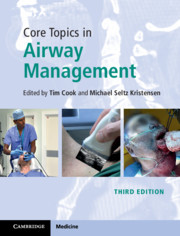Book contents
- Core Topics in Airway Management
- Core Topics in Airway Management
- Copyright page
- Contents
- Contributors
- Foreword
- Preface to the Third Edition
- Section 1 Airway Management: Background and Techniques
- Section 2 Airway Management: Clinical Settings and Subspecialties
- Chapter 22 The Airway in Obstetrics
- Chapter 23 The Paediatric Airway
- Chapter 24 Airway Management in Obesity
- Chapter 25 Maxillofacial and Dental Surgery
- Chapter 26 Ear, Nose and Throat Surgery: Airway Management
- Chapter 27 Lung Separation
- Chapter 28 Airway Management in the Critically Ill
- Chapter 29 The Patient with a Tracheostomy
- Chapter 30 Pre-hospital and Trauma Airway Management
- Chapter 31 Airway Management during CPR
- Chapter 32 The Bloody and Bleeding Airway
- Chapter 33 The Airway in Anaesthesia for Transoral Robotic Surgery
- Section 3 Airway Management: Organisation
- Index
- References
Chapter 30 - Pre-hospital and Trauma Airway Management
from Section 2 - Airway Management: Clinical Settings and Subspecialties
Published online by Cambridge University Press: 03 October 2020
- Core Topics in Airway Management
- Core Topics in Airway Management
- Copyright page
- Contents
- Contributors
- Foreword
- Preface to the Third Edition
- Section 1 Airway Management: Background and Techniques
- Section 2 Airway Management: Clinical Settings and Subspecialties
- Chapter 22 The Airway in Obstetrics
- Chapter 23 The Paediatric Airway
- Chapter 24 Airway Management in Obesity
- Chapter 25 Maxillofacial and Dental Surgery
- Chapter 26 Ear, Nose and Throat Surgery: Airway Management
- Chapter 27 Lung Separation
- Chapter 28 Airway Management in the Critically Ill
- Chapter 29 The Patient with a Tracheostomy
- Chapter 30 Pre-hospital and Trauma Airway Management
- Chapter 31 Airway Management during CPR
- Chapter 32 The Bloody and Bleeding Airway
- Chapter 33 The Airway in Anaesthesia for Transoral Robotic Surgery
- Section 3 Airway Management: Organisation
- Index
- References
Summary
Pre-hospital airway management is an essential skill for every pre-hospital clinician and should be performed to the same standards as would be expected in the emergency department. This chapter recommends tailored pre-hospital airway management in terms of clinical care delivered to the patient, skills of the clinician and the infrastructure of emergency medical system to achieve this. The importance of having a standardised, well-rehearsed approach, using aids to reduce cognitive load, articulating a clear airway management plan and having a structured way of handling airway management difficulties is highlighted. The concept of the physiologically difficult airway is discussed and the significance of excellent pre-oxygenation, peroxygenation, first-pass success and post-intubation care is discussed. Backup equipment in the form of second generation supraglottic airway devices, a videolaryngoscope with both standard and hyperangulated blades and equipment for an emergency front of neck airway should be available when advanced pre-hospital airway management is provided. When delivering airway management to trauma patients, an awareness of potential anatomical difficulties combined with careful management of physiological derangement is necessary to deliver safe, high quality care.
Keywords
- Type
- Chapter
- Information
- Core Topics in Airway Management , pp. 270 - 277Publisher: Cambridge University PressPrint publication year: 2020

